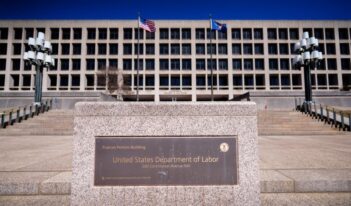
Recent appellate judge’s dissent charts a radical approach to the nondelegation doctrine.
A majority of Supreme Court Justices have expressed an interest in reinvigorating the non-delegation doctrine—a doctrine that the Court has used as the basis for holding a statute unconstitutional in only two cases, both of them eighty years ago. Yet a 29-page dissenting opinion of Judge John Nalbandian, released last week in a U.S. Court of Appeals for the Sixth Circuit’s case, illustrates a path that the Supreme Court might well again take to strike down legislation on nondelegation doctrine grounds. Such a radical step would have extraordinary effects.
Judge Nalbandian would hold that the Occupational Safety and Health (OSH) Act is unconstitutional because its primary decisional standard does not pass the “intelligible principle” test. He recites and applies the reasoning and conclusions in the two 1935 opinions in which the Court held that two provisions of the National Industrial Recovery Act did not pass the “intelligible principle” test because they contained no decisional standards at all. Judge Nalbandian concludes that the OSH Act is also unconstitutional because it grants the Secretary of Labor “nearly unfettered discretion” to impose safety standards on employers.
The statutory provision at issue instructs the Secretary to issue workplace safety rules that are “reasonably necessary or appropriate.” The majority held that the statute passed the “intelligible principle” test because it limited the Secretary’s discretion, particularly when the decisional standard is combined with the many statements of the principles, purposes, and goals of the statute and the rigorous procedure the agency is required to use to issue a safety rule.
The majority also referred to the dozens of cases in which the Supreme Court has upheld the constitutionality of statutes with decisional standards that are broader than the standard at issue. The Court has upheld, for instance, statutes in which the only decisional standard was a requirement that an agency must act in ways that are “just and equitable,” “fair and equitable,” or “in the public interest.”
It is important to consider Judge Nalbandian’s opinion in the context of the thousands of statutory provisions that are contained in the U.S. Code. The statute at issue in the Sixth Circuit case—the OSH Act—was enacted over half a century ago. It has been applied in tens of thousands of cases in which workplace safety and health regulations have saved many lives. If the nondelegation doctrine can be used as the basis to strike it down, then most other federal statutes are likely to meet the same fate no matter how old they are nor how often they have been applied.
Most of the statutes that Congress has enacted contain extremely broad decisional standards. In 1887, for example, Congress instructed the Interstate Commerce Commission to set rail rates that are “just and reasonable.” Congress then used similar language in establishing the primary decisional standard in many other statutes, including the Natural Gas Act and the Federal Power Act.
As of 2023, a search in the U.S. Code for the phrase “just and reasonable” appears in more than 150 places. This phrase is also used as the primary decisional standard in many state statutes.
As I have explained in detail in prior writings, for decades after Congress started instructing agencies to act in a “just and reasonable” manner, the Supreme Court attempted to give this standard a finite meaning. By 1944, it finally gave up and announced that there was no method of ratemaking that was required or prohibited by the standard. Any rate was acceptable as long as it produced an acceptable “end result.”
The Court never explained how a court could decide whether the “end result” of an agency’s application of the ubiquitous “just and reasonable” test was acceptable. After many unsuccessful attempts to explain the “end result” test, the Court announced that there is a “zone of reasonableness” within which any agency decision complies with the “just and reasonable” standard. The Court characterized that zone as “broad.” Later applications of the standard confirmed that description. Thus, for instance, within just a few years courts upheld as “just and reasonable” agency rates that varied by a factor of ten to one.
The “just and reasonable” standard is just one of many extraordinarily broad standards that Congress has included in the myriad statutes that it has enacted throughout the history of the nation. Hundreds of other statutes have broad standards, such as “public interest” and “public convenience and necessity.” If the “reasonably necessary or appropriate” standard is unconstitutional, it is just a matter of time before courts hold most other federal statutes unconstitutional. That would confront Congress with the daunting task of enacting thousands of new statutes that comply with a new judicially crafted nondelegation doctrine.
Congress’s decision to include only broad decisional standards in most statutes should not be cause for concern. Agencies must use notice-and-comment rulemaking to promulgate rules. That procedure often creates administrative records that span thousands of pages and include numerous studies relevant to the agency’s application of the statute that it is implementing. The agency must then issue a statement of basis and purpose in which it explains in detail why it has concluded that a safety rule is consistent with the statute. Thus, for instance, the agency that is responsible for implementing the OSH Act must explain why the rule that it is issuing is “reasonably necessary or appropriate” and consistent with the many principles, purposes, and goals stated in the statute based on the evidence generated by the notice-and-comment process.
A court then reviews the agency’s action with particular attention to the quality and thoroughness of its reasoning in support of its conclusion that the rule is “reasonably necessary or appropriate” and consistent with the principles, purposes, and goals of the statute. The court also ensures that the action is consistent with the agency’s policies and precedents or that the agency has provided a satisfactory explanation for any departure from precedent. If the court concludes that the agency has not satisfactorily explained the basis for its action, it rejects the action as arbitrary and capricious.
That decision-making process certainly leaves agencies with some residual discretion about which safety rules to promulgate. But it is important to remember that agencies are accountable to the president, and the president is accountable to the people. Any president who allows an agency to act in ways that displease the public will pay a political price.




